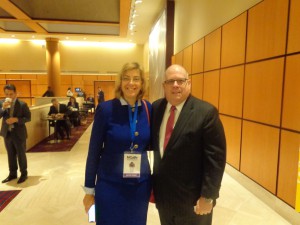However, challenges remain in terms of education and empowerment.
Washington, D.C., March 27 – Even as the national employment rate continues to increase, more Marylanders with disabilities are entering the workforce. A new analysis published by RespectAbility, a national nonprofit organization that fights stigmas and advances opportunities for people with disabilities, reports that Maryland now ranks 17th in the nation for employment of people with disabilities. In total there are 334,505 working-age Marylanders with disabilities and 137,517 have jobs. Last year, 5,944 more people with disabilities entered Maryland’s workforce.

In recognition of this pool of mostly untapped workers, here are some of the efforts that Maryland has made. In October 2017, Governor Larry Hogan gave a clear statement of his state’s comment to disability employment. The Governor recognized that “including people with disabilities” in the workplace “are a critical part of efforts to build an inclusive community and strong economy.” He went on to add his view that “employment is often the most direct and cost-effective means to empower people with disabilities” and that “public awareness is necessary to reduce the barriers face by Marylanders with disabilities.” Lastly, he also pointed out to self-employment and entrepreneurship as a “growing and viable option for many with disabilities.”
In 2016 Governor Hogan signed the Ken Capone Equal Employment Act into law, promising to eliminate sheltered workshops where employees with disabilities receive subminimum wages. Rachel London, the deputy director of the Maryland Developmental Disabilities Council, said that the Council has funded customized technical assistance for 23 service provider agencies throughout Maryland to transform their practices. “Grantees were selected for demonstrating a strong commitment to ensuring people work and meaningfully participate in their communities by making deep and lasting organizational change,” London said, “These organizations demonstrated a willingness and readiness to change the way services and supports are provided, reflecting the Council’s mission to advance the inclusion of people with developmental disabilities in all facets of community life.”
Maryland is also making good use of federal dollars. Last year Maryland received an updated Disability Employment Initiative (DEI) grant. This grant, from the Office of Disability Employment Policy, will fund local resource coordinators to help students and job-seekers with disabilities to take advantage of existing programs across state agencies for employment.
In September, The Maryland Higher Education Commission Capacity Building invited agencies and Maryland schools to an Institute on Inclusive Higher Education options for youth with intellectual disabilities. Their goal was to present best practices that school systems and agencies could use, as a team, to develop and support inclusive education programs.
These efforts are starting to make a difference in the lives of Marylanders with disabilities. However, big gaps remain in terms of employment, education and empowerment. When compared to the 80.2 percent of Marylanders without disabilities that are employed, Marylanders with disabilities have an employment rate of 41.1 percent. That means there is only a 39.1 percentage point employment gap in the labor force, showing the inclusiveness of Maryland’s economy.
According to RespectAbility, which fights stigmas and advances opportunities for people with disabilities, the steps Maryland has taken are the ones necessary to improving employment. “Maryland sees the talent of people with disabilities – who can be the most gifted people on earth,” says Jennifer Laszlo Mizrahi, president of Respectability. “Richard Branson, Whoopie Goldberg, Daymond John and Charles Schwab are all dyslexic. Steven Hawking uses a mobility device. Arthur Young, the co-founder of Ernst & Young, one of America’s largest companies, was deaf and had limited vision.”
Mizrahi went on to add that “the necessary condition for achieving greater competitive, integrated employment is engaging employers and meeting their talent needs.” Companies including JP Morgan Chase, Pepsi, UPS, SAP, EY, IBM, Starbucks, and Walgreens are case studies that show people with disabilities are successful employees. They also show that these workers improve businesses’ bottom lines. More employers must be educated about the skill sets that people with disabilities bring to the workplace. A Maryland-specific example of this is the health care provider Aetna. Nationally, Aetna has been recognized by the US Business Leadership Network for their efforts to recruit, hire and retain employees with disabilities. Locally, Aetna has also created policies that embed accommodations into the daily work routine. They also provide ADA counseling to the HR managers of the companies that have purchased their employee insurance package.
A national example of inclusive employment comes from Jim Sinocchi, the head of disability inclusion for JP Morgan Chase. He believes that employees with disabilities are valuable employees and promises that JP Morgan is committed to full inclusion, which “requires a leadership team with the will, commitment and attitude to identify, train and groom professionals with disabilities for leadership positions at the firm as we do with mainstream employees.”
“Yet employment rates only tell part of the story,” adds Philip Kahn-Pauli, Policy and Practices Director at RespectAbility, “Educational attainment is critical to the success of youth with disabilities because the jobs of the future require technical education and skill training.” Maryland had an overall high-school graduation rate of 90 percent in 2016, but only 67 percent of the students with disabilities graduated. This is a massive barrier to success in employment and life, and has caused many people with disabilities to enter the school-to-prison pipeline. Disability & Criminal Justice Reform: Keys to Success documented that more than 750,000 people with disabilities are behind bars in America today.
Yet there are optimistic signs. National statistics show 343,483 more people with disabilities joined the American workforce in 2016. This is four times the rate of the previous year. After all, as Jennifer Laszlo Mizrahi, President of Respectability, said: “Our nation was founded on the principle that anyone who works hard should be able to get ahead in life. People with disabilities deserve the opportunity to earn an income and achieve independence, just like anyone else.”
View data on all states: New Jobs for People with Disabilities, 4X the Previous Year – 343,483 new jobs for people with disabilities!
For more information on state initiatives: http://drivedisabilityemployment.org

Be First to Comment